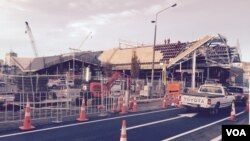Just over four years ago, New Zealand suffered one of its most catastrophic earthquakes. In February 2011, a magnitude 6.3 tremor shook the city of Christchurch. More than 180 people died. In the years since, authorities have made great efforts to make the city resistant to future tremors – and their work is now slowly taking shape.
More than 1,000 buildings have been demolished in the center of Christchurch since the earthquake struck in February 2011, and the major reconstruction phase is well underway.
John Ombler, acting head of the government-appointed agency overseeing the rebirth of this famous city, said strict building codes will ensure that Christchurch will have some of the safest buildings in the world.
“At ground level there are foundations that can move with an earthquake. There is one large office block here that is on 19 very large ball bearings, so that in case of an earthquake it can move half-a-meter in any direction depending on the severity of the earthquake and then just gradually settle back into its right place so that buildings can wobble around a little bit. They are designed to do so. There is a huge amount of work goes on, huge excavation, huge expenditure into the foundations long before it comes out of the ground. So foundation design [is] absolutely critical,” said Ombler.
The task of rebuilding the city will cost more than $27 billion. There have been delays because of more seismic activity, the processing of insurance payouts and red tape.
But Deon Swiggs, the director of Rebuild Christchurch, a community campaign group, said temporary measures, such as a shopping center made up of shipping containers, have helped the city to cope.
“Right now we are in the Re: Start Mall, which is a container pop up that was set up after the earthquakes. We lost a lot of our central city business district, all our shopping businesses and buildings. By November next year the development along Cashel St that we are looking at now that should be built. That is going to be retail [and] office space. There is about 1,200 office people from the government that have already signed leases to go into these buildings,” sasid Swiggs.
A key part of the Christchurch recovery has been the influx of foreign labor. Immigration rules have been eased to allow migrants to play a crucial part in accelerating the rebuilding effort. Up to 25,000 foreign workers have been involved. The largest group is from the Philippines, followed by the United Kingdom.
New Zealand’s minister for economic development, Steven Joyce, said imported labor is helping to create a brand new city.
“Filipinos, Irish, people from the UK. We have brought a lot of them in. They’ll add to the mix and the vibrancy of the city. I have always thought that despite the earthquakes were one of the worst things that happened and could happen, out of it we will have a stronger, more vibrant, more resilient second city and capital of the South Island than we would have had otherwise, and these people will contribute to that,” said Joyce.
Tom Hooper, the chief executive of the Canterbury Development Corporation, sees a bright future ahead.
“Old Christchurch is gone, new Christchurch will emerge and it is all about that new Christchurch and how we make it exciting, and vibrant and attractive, and just the coolest little city in the world,” said Hooper.
Building work will continue for more than a decade. Authorities say the goal is to create a city that is safe from future seismic shocks.






